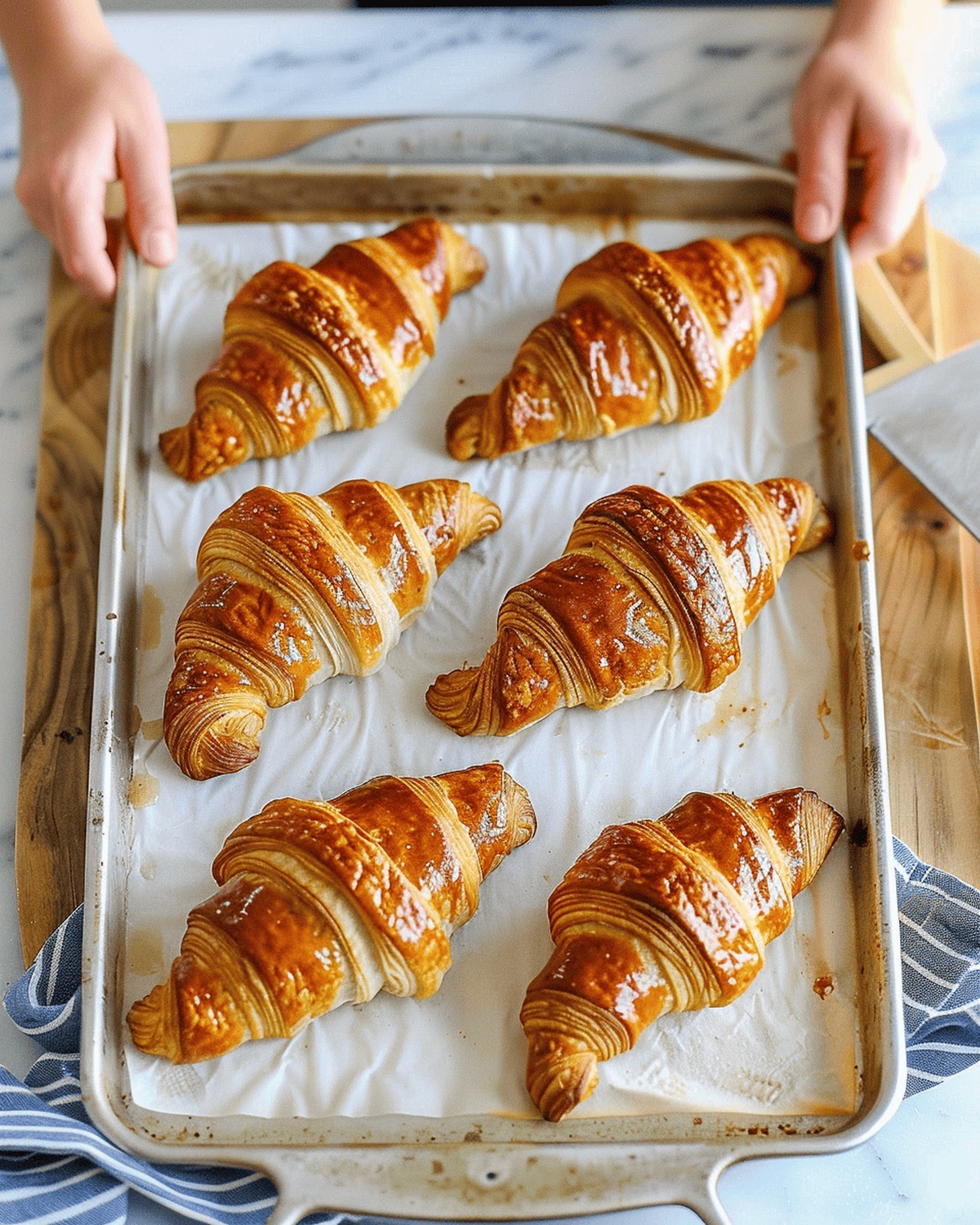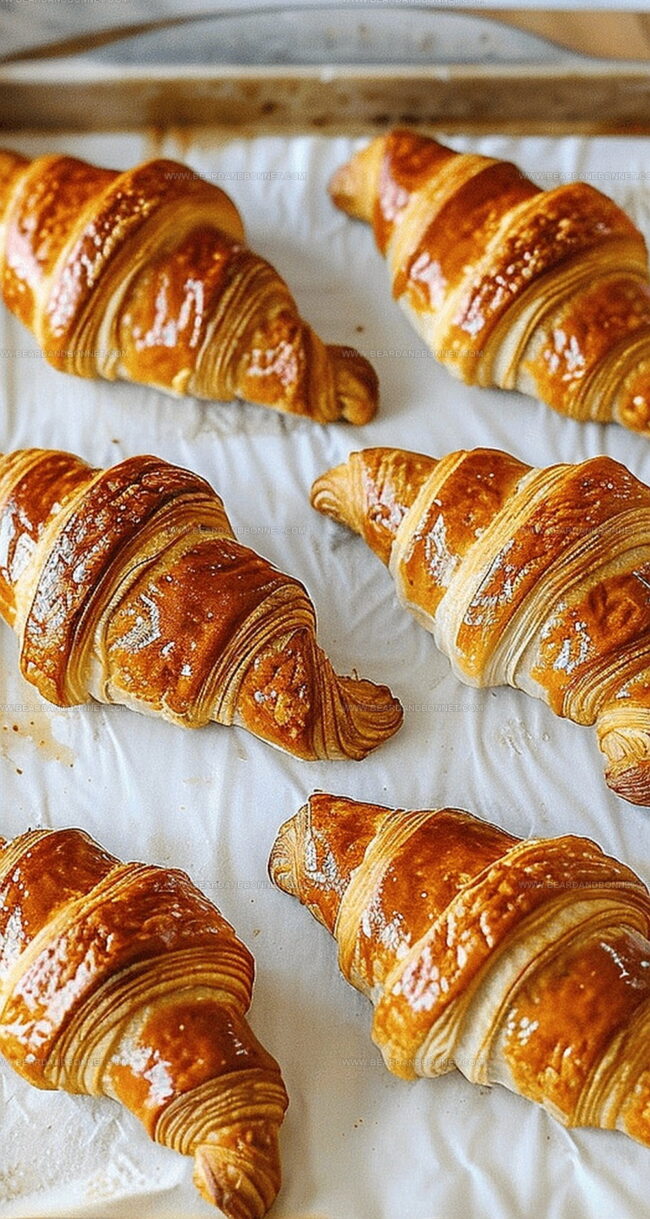Flaky Croissant Recipe: Breakfast Magic in Minutes
Buttery, flaky layers of homemade croissant delight recipe dance with golden-brown perfection on your plate.
European bakeries have nothing on this delectable creation.
Each fold whispers culinary secrets passed down through generations of passionate bakers.
The delicate pastry melts with rich, creamy textures that promise pure indulgence.
Crisp exterior gives way to soft, tender inner layers that make every bite a celebration.
Professional and home bakers alike will fall in love with this irresistible treat.
Dive into this recipe and unlock the magic of perfect, mouthwatering croissants that will steal the show at any breakfast or brunch.
Quick Recipe Overview
What’s Inside a Croissant
For Dough Base:For Liquid Components:For Layering:Tools That Shape a Great Croissant
Croissant: How to Build It Easily
Mix flour, sugar, salt, and yeast in a stand mixer. Add water, milk, and softened butter. Knead until a smooth ball forms. Let the dough rise in a warm spot until it nearly doubles in size. Refrigerate after shaping into a square.
Slice butter into even slabs. Create a perfectly flat butter square by pounding between parchment paper. Chill thoroughly.
Wrap butter inside the dough like a delicate package. Seal edges carefully to prevent any leakage.
Roll dough into a long rectangle. Fold into elegant thirds. Chill the dough between each folding session. Repeat this process three times to create signature flaky layers.
Stretch dough into a long, narrow strip. Cut into delicate triangles. Roll each triangle from base to tip, creating those iconic curved croissant shapes. Let the croissants rest and rise before baking to golden perfection.
Croissant Upgrades for More Flavor
Croissant: Presentation Ideas
How to Store Your Croissant
Print
Buttery Croissant Recipe
- Total Time: 1 hour 50 minutes
- Yield: 13 1x
Description
Classic French Croissant Delight merges buttery layers with delicate pastry techniques from Paris. Flaky, golden crescents provide a luxurious breakfast experience you will savor with pure culinary pleasure.
Ingredients
- 1¼ cups (284 g) cold, unsalted European-style butter
- 18 oz (510 g) all-purpose flour
- ½ cup (120 ml) cold whole milk
- ½ cup (120 ml) cold water
- 1 large egg
- 1 egg yolk
- 3 tbsps unsalted butter, softened
- ¼ cup + 1 tbsp (55 g) granulated sugar
- 2½ tsps fine sea salt
- 1 tbsp + ½ tsp instant yeast
- Pinch of salt
Instructions
- Dough Preparation: Combine dry ingredients in a stand mixer, gradually blend in liquids and soft butter until a smooth, elastic dough forms. Knead thoroughly to achieve a silky texture.
- Fermentation and Chilling: Let dough rise in a warm, draft-free spot until volume doubles. Refrigerate and transform into a compact square, allowing gluten to relax and develop structure.
- Butter Integration: Create a uniform butter block by flattening between parchment paper, maintaining cool, consistent temperature and even thickness.
- Butter Encasement: Position chilled butter diagonally on dough, meticulously fold edges to completely seal the butter within, creating a seamless protective layer.
- Lamination Process: Roll dough into an elongated rectangle, fold in precise thirds. Refrigerate between each fold to preserve delicate layer structure, repeating folding sequence twice to develop intricate, gossamer-thin pastry layers.
- Shaping Technique: Roll out laminated dough, cut into triangular shapes. Stretch and roll each triangle from wide base to pointed tip, creating classic curved croissant silhouettes with elegant, distinctive shape.
- Final Proofing and Baking: Allow shaped pastries to rise gently, then bake until achieving a golden, crisp exterior with delicate, flaky interior.
Notes
- Butter Temperature Matters: Keep butter consistently cool but pliable to achieve perfect lamination without melting or breaking during folding.
- Patience Prevents Failure: Allow sufficient resting time between folding stages, chilling dough helps develop structured, flaky layers and prevents butter from integrating completely.
- Precision is Key: Use consistent, measured rolling techniques with even pressure to create uniform, gossamer-thin layers that guarantee the signature croissant texture.
- Temperature Control Critical: Maintain cool environment during entire process, preventing butter from melting and ensuring clean, distinct layers that create signature crisp, flaky pastry structure.
- Prep Time: 1 hour 30 minutes
- Cook Time: 20 minutes
- Category: Breakfast, Snacks, Desserts
- Method: Mixing
- Cuisine: French
Nutrition
- Serving Size: 13
- Calories: 309
- Sugar: 10.5 g
- Sodium: 160 mg
- Fat: 20 g
- Saturated Fat: 12 g
- Unsaturated Fat: 8 g
- Trans Fat: 0.5 g
- Carbohydrates: 30 g
- Fiber: 1 g
- Protein: 4 g
- Cholesterol: 50 mg




Jessica Martin
Recipe Developer & Food Writer
Expertise
Recipe Development, Food Styling and Photography, Seasonal and Local Ingredients, Vegetarian and Vegan Cuisine, Culinary Education
Education
Portland Community College
Oregon Culinary Institute
Jessica Martin is a talented food writer and recipe creator who specializes in seasonal cooking and approachable home baking.
Educated at Portland Community College with additional pastry training from Oregon Culinary Institute, Jessica’s culinary journey spans nearly a decade of creating and sharing flavorful recipes.
Her deep appreciation for local ingredients shapes each of her recipes, making them both accessible and inspiring. At Beard and Bonnet, Jessica uses her cheerful, down-to-earth writing to help readers effortlessly bring new tastes and creative dishes into their daily routines.